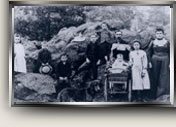History of Vandeverts
By Nancy Strope, Redmond 1970
It’s always fun to look back to life as it was during the homesteader days. Claude Vandevert, one of Central Oregon’s few living early day settlers, still lives on the original homestead.
Claude’s father, William Plutarch Vandevert, was born in 1854 in Cottage Grove. As a young man he carried mail during the Modoc War of 1873 between Alturas and Fort Bidwell in California.
After the war he camped near a spring on what is now the Vandevert Ranch, located just 18 miles south of Bend on Vandevert Road. Little River flows aimlessly past the back door. The old immigrant trail marches right past the barn door. Bill vowed to return to this peaceful spot beside the river, but the time wasn’t right. A restlessness urged him on. He traveled on to Texas where he met the girl who was to become his wife. They in turn moved to New York City, New York. During these years, six children were born to the family.
In spite of life’s responsibilities, Bill just couldn’t get the spring beside the river in Oregon out of his mind. In 1891 they packed all their earthly belongings and all the children except the oldest daughter, who stayed behind with family to further her education, and took the train to The Dalles. Here the bustling nation’s last frontier was still a land of sage and sand with very little water save the swift-running Deschutes River. The Deschutes River was not a river to travel because of its rapids and cascades. But, as if in compensation, the greenish blue waters churned into a foam heavy laden with trout. Salmon ascend its lower portion but do not reach the upper course because of the falls.
When the family reached The Dalles, it was then necessary to buy wagons and horses, for this was the end of the railroad line. (The railroad connection from The Dalles to Shaniko, further south, was not built until 1900. – ed.) It was still another 155 miles from The Dalles to their destination. First they went to Bill’s father’s home for it was late fall and time was needed to build a home for his family. Then, too, Sadie felt the need to be with family for Claude was born January 6 of that winter. It was then the year of 1892. In the spring the Vandeverts traveled on to their destination, the spring by the river, just 42 miles to the southwest.
Bill homesteaded the land on which the old home still stands and bought the adjoining land on which the spring was located. At a later date another son was born to the family, making a total of five sons and three daughters.
The home was built well and cared for lovingly, for it still stands today, in exceptionally good condition. It was to see five generations come and go. Claude, who had virtually lived all of his life on the Homestead, has in most recent years built a new home within a stone’s throw of the old family home.
As we sat before the fire in the cozy living room of his new home, Claude, a large well-built man of kindly eyes and a keen mind, reminisced of days gone by – of a time when it took five days to make a round trip to Prineville for supplies. You could always count on a trip in the fall when supplies included a ton of flour from the mill in Prineville. It takes a lot of bread, sourdough biscuits, hot cakes, and bonnock to keep a large family going. (“Bannock” is a large, flat, quick-rising bread that can be cut into scones. – ed.)
The only fruit in Eastern Oregon at that time was the wild plums of the Summer Lake area. Four or five hundred pounds were gathered each fall and made into plum butter. Wild strawberries were a special treat.
Every two or three years the family would load the wagon with empty fruit jars and supplies for a long trip and head out for the Willamette Valley by way of the McKenzie Pass. This pass itself is one of nature’s phenomena. Crossing the Belknap Crater lava flow, it winds and twists down the mountainside to the McKenzie River. Portions of the old McKenzie Salt Springs and Deschutes Wagon Road are still visible. Built in 1866 to 1872, it became a toll road in 1872, a free country road in 1898, and a state highway in 1917.
Windy Point, a roadbed of lava rock across the Yapoah flow, was one of the most treacherous crossings. The wind blows unceasingly at gale force here. Travelers would always dismount and lead their teams for the road was only two feet wider than a team and wagon. Perched precariously on the edge of the road was a sign which read, “Hell – ¼ mile.” An arrow pointed straight down! All that marks Windy Point today is the remains of the old road and a dead juniper standing alone and forlorn.
By the time the Vandeverts reached the Mountain House, it had been a long four-day journey with two more days to go before they would reach their destination. Belknap Hot Springs (near the Mountain House – ed.), where they could bathe in all the water they wanted at any temperature they wanted, was just sheer luxury.
In homesteader days, keeping the family larder filled was a never-ending task. It was a six-day journey with a wagon and team from the Vandevert homestead to the valley where fruit and vegetables grew in abundance. This sojourn for supplies was not an easy one, however. It was a journey greatly looked forward to for, in those days, family fun was always a part of the scene.
The end result of these trips was fruits and vegetables of every kind. Everyone helped to can the fruit and vegetables, filling the many jars which had been brought from home. The trip usually took a good three weeks, for 12 days travel time was required to make the 256 mile round trip.
Even in those days a camping trip was a treat. As Claude reminisced, he told of the year the “kids” went to Crescent – that took one day – then to Crescent Lake where they fished and hunted. From there they went to Odell, on to Crane Prairie, and then back home again. They were gone for three weeks.
The summer that really stands out in his memory was the one that he was fourteen. It was 1905, the year of the Lewis and Clark Centennial in Portland. This was a big event in the life of anyone, but to a boy from the last frontier, it was another world.
This was an event that “Old Bill” as he was affectionately known, didn’t want his family to miss. A great deal of excitement and planning went into the preparations of getting ready to go. At last the big day arrived and the family started out with the supply wagon and horses, for they would bring back all the fruit and canned goods they could. This in itself was a treat.
The first night was spent in Bend. From there they steadily worked themselves across the Santiam Pass to Salem and on up to Portland where the sights to behold were enough to set a boy’s head whirling. Every crook and cranny of the fair was to be observed and delighted in. When all had their “fill” and home thoughts began to beckon, they loaded the wagon with the supplies at Portland and proceeded up the Columbia to Hood River.
Here the road ended and it was necessary to load everything and everyone onto one of the river barges that carried them to The Dalles. This portion of the trip cost the family $24.50 passage. Upon reaching The Dalles, they once again set off by land up the Deschutes River Road – on up through the never-ending sage brush, sand, and prairie grass. Even today this is a lonely stretch of country to the average traveler. Home never looked so good, for they had traveled a good 500 miles and filled themselves with enough memories in one … (End of document. – ed.)
|






